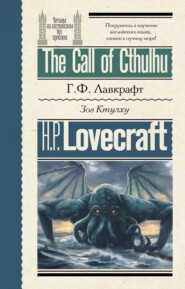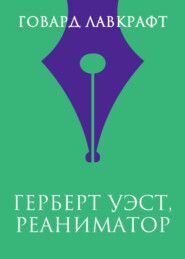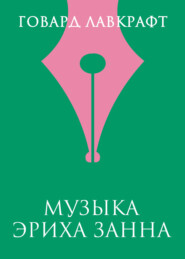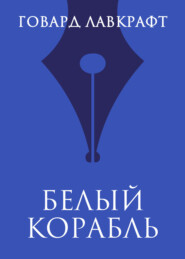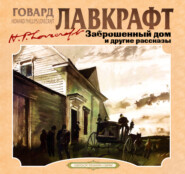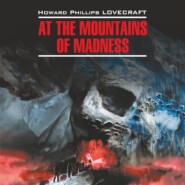По всем вопросам обращайтесь на: info@litportal.ru
(©) 2003-2025.
✖
The Call of Cthulhu / Зов Ктулху
Настройки чтения
Размер шрифта
Высота строк
Поля
One day came rescue – the Vigilant, the vice-admiralty court, the streets of Dunedin, and the long voyage back home to the old house. He could not tell – they would think him mad[102 - they would think him mad – его бы сочли за сумасшедшего]. He wrote of what he knew before death came. Death would be a boon if only it could delete memories.
That was the document I read, and now I have placed it in the tin box beside the bas-relief and the papers of Professor Angell. This record of mine will be placed with them. I do not think my life will be long. As my uncle went, as poor Johansen went, so I shall go. I know too much, and the cult still lives.
Cthulhu still lives, too, I suppose, again in that chasm of stone which has shielded him since the sun was young. His accursed city is sunken once more, for the Vigilant sailed over the spot after the April storm; but his ministers on Earth still bellow and prance and slay around idol-capped monoliths in lonely places. Who knows the end? What has risen may sink, and what has sunk may rise. It waits and dreams in the deep, and decay spreads over the tottering cities of men. A time will come – but I must not and cannot think about it! Let me pray that, if I do not survive this manuscript, my executors let nobody read this.
At the Mountains of Madness
I
I don’t want to tell my reasons for opposing the invasion of the Antarctic – with its vast fossil hunt and its melting of the ancient ice caps. I can understand clearly that my story will seem extravagant and incredible. But there are photographs, both ordinary and aerial, and they will count in my favor[103 - in my favor – в мою пользу], for they are vivid and graphic. Of course, some people can say that is all fakery. And there are ink drawings which can be jeered at as obvious impostures.
I must rely on the judgment and standing of the few scientific leaders who have, on the one hand, sufficient independence of thought; and on the other hand, sufficient influence to deter the exploring world in general from any over-ambitious program in the region of those mountains of madness. It is pity that ordinary men like myself and my colleagues, connected only with a small university, have little chance of making an impression.
In the strictest sense, we are not specialists in the fields concerned. Miskatonic University[104 - Miskatonic University – Мискатоникский университет (вымышленный университет, расположенный в вымышленном городе Аркхем, штат Массачусетс, США).] sent me as a geologist. The aim of our expedition was to secure deep-level specimens of rock and soil from various parts of the Antarctic continent. We had a remarkable drill devised by Professor Frank H. Pabodie[105 - Frank H. Pabodie – Фрэнк Х. Пэбоди] of our engineering department. I had no wish to be a pioneer in any other field than this, but I hoped that the use of this new mechanical device would discover materials, unacceptable by the ordinary methods of collection.
Pabodie’s drilling apparatus was unique and radical in its lightness, portability, and capacity. Three sledges could carry steel head, jointed rods[106 - jointed rods – складной хвостовик бура], gasoline motor, collapsible wooden derrick[107 - collapsible wooden derrick – разборная деревянная буровая вышка], dynamiting paraphernalia[108 - dynamiting paraphernalia – принадлежности для взрывных работ], cords, rubbish-removal auger, and sectional piping for bores five inches wide and up to one thousand feet deep. This was possible due to aluminum alloy. Four large aeroplanes could transport our entire expedition from a base at the edge of the great ice barrier to various inland points.
We planned to explore a great area, operating mostly in the mountain ranges and on the plateau south of Ross Sea[109 - Ross Sea – море Росса (море в Тихом океане у берегов Земель Виктории и Мэри Бэрд, Западная Антарктида)]; regions explored by Shackleton, Amundsen, Scott, and Byrd[110 - Shackleton, Amundsen, Scott, and Byrd – Шеклтон, Амундсен, Скотт и Бэрд]. We expected to get a quite unprecedented amount of material – especially in the pre-Cambrian[111 - pre-Cambrian – докембрийский период (криптозой, предшествовал началу кембрийского периода (около 540 млн. лет назад)] strata. We wished also to obtain a variety of the upper fossiliferous rocks, since the primal life history of this realm of ice and death is of the highest importance to our knowledge of the Earth’s past. The Antarctic continent was once temperate and even tropical; and we hoped to expand that information in variety, accuracy, and detail.
The public knows of the Miskatonic Expedition through our frequent reports to the Arkham Advertiser and Associated Press[112 - Arkham Advertiser and Associated Press – «Аркхемский листок» и «Ассошиэйтид Пресс»], and through the later articles of Pabodie and myself. There were four men from the University – Pabodie, Lake[113 - Lake – Лэйк] of the biology department, Atwood[114 - Atwood – Этвуд] of the physics department – also a meteorologist – and myself, representing geology – besides sixteen assistants: seven graduate students from Miskatonic and nine skilled mechanics. Of these sixteen, twelve were qualified aeroplane pilots, they were competent wireless operators as well. Eight of them understood navigation with compass and sextant, as did Pabodie, Atwood, and I. In addition, of course, our two ships were fully manned[115 - were fully manned – были полностью укомплектованы командами].
The Nathaniel Derby Pickman Foundation[116 - Nathaniel Derby Pickman Foundation – Фонд Натаниэла Дерби Пикмена] financed the expedition. The dogs, sledges, machines, camp materials, and unassembled parts of our five planes were delivered in Boston, and there our ships were loaded. We were marvelously well-equipped for our specific purposes. As the newspapers told, we sailed from Boston Harbor on September 2nd, 1930, taking a leisurely course down the coast and through the Panama Canal[117 - Panama Canal – Панамский канал], and stopping at Samoa and Hobart, Tasmania[118 - Samoa and Hobart, Tasmania – Самоа и Хобарт, Тасмания], where we got final supplies. Our ship captains were J. B. Douglas[119 - J. B. Douglas – Дж. Б. Дуглас], commanding the brig Arkham, and Georg Thorfinnssen[120 - Georg Thorfinnssen – Георг Торфинсен], commanding the Miskatonic – both veteran whalers in Antarctic waters.
At about 62° South Latitude we noticed our first icebergs – table-like objects with vertical sides – and just before reaching the Antarctic circle[121 - Antarctic circle – Южный полярный круг], which we crossed on October 20th with appropriately ceremonies, we were considerably troubled with field ice. The falling temperature bothered me considerably after our long voyage through the tropics. Very often the curious atmospheric effects enchanted me vastly; distant bergs became the battlements of unimaginable cosmic castles.
Pushing through the ice, we regained open water at South Latitude 67°, East Longitude 175°. On the morning of October 26th a snow-clad mountain chain appeared on the south. That was an outpost of the great unknown continent and its cryptic world of frozen death. These peaks were obviously the Admiralty Range discovered by Ross[122 - Admiralty Range discovered by Ross – Адмиралтейские горы, открытые Россом], and our task was to round Cape Adare[123 - Cape Adare – мыс Адэр (мыс и полуостров, расположенные на крайнем северо-востоке региона Земля Виктории, Восточная Антарктида)] and sail down the east coast of Victoria Land[124 - Victoria Land – Земля Виктории (район Антарктиды)] to our base on the shore of McMurdo Sound[125 - the shore of McMurdo Sound – побережье пролива Мак-Мердо (Мак-Мердо – пролив в Антарктиде, покрытые льдом воды которого простираются приблизительно на 55 км в длину и ширину. На севере пролив выходит в Море Росса).], at the foot of the volcano Erebus[126 - Erebus – Эребус] in South Latitude 77° 9’.
The last part of the voyage was vivid and fancy-stirring. Great barren peaks of mystery, white snow, bluish ice and water lanes, and black bits of exposed granite slope. Something about the scene reminded me of the strange and disturbing Asian paintings of Nicholas Roerich[127 - Nicholas Roerich – Николай Рерих (1874–1947), русский художник, сценограф, философ-мистик, писатель, путешественник, археолог, общественный деятель.], and of the disturbing descriptions of the evil plateau of Leng[128 - plateau of Leng – плоскогорье Ленг (упоминаемое Лавкрафтом холодное и пустынное плато)] which appear in the dreaded Necronomicon of the mad Arab Abdul Alhazred. I was rather sorry, later on, that I had looked into that monstrous book at the college library.
On the 7th of November, we passed Franklin Island[129 - Franklin Island – остров Франклина (скалистый остров в проливе Кеннеди в составе пролива Нэрса, практически в центральной части Арктики)]; and the next day the cones of Mts. Erebus and Terror[130 - Mts. Erebus and Terror – вулканы Эребус и Террор] on Ross Island appeared, with the long line of the Parry Mountains[131 - Parry Mountains – горы Перри] beyond. There was a white line of the great ice barrier, rising perpendicularly to a height of two hundred feet like the rocky cliffs of Quebec, and marking the end of southward navigation. In the afternoon we entered McMurdo Sound and stood off the coast[132 - stood off the coast – встали на якорь] near Mt. Erebus. Beyond it rose the white, ghostlike height of Mt. Terror, ten thousand, nine hundred feet in altitude.
One of the graduate assistants – a brilliant young fellow named Danforth[133 - Danforth – Данфорт] – noticed lava on the snowy slope. On the barren shore, and on the lofty ice barrier in the background, myriads of grotesque penguins walked.
Using small boats, we landed on Ross Island shortly after midnight on the morning of the 9th, preparing to unload supplies. Our camp on the frozen shore below the volcano’s slope was only a provisional one, headquarters were situated aboard the Arkham. We landed all our drilling apparatus, dogs, sledges, tents, provisions, gasoline tanks, experimental ice-melting outfit[134 - experimental ice-melting outfit – экспериментальное оборудование для растапливания льда], cameras, both ordinary and aerial, aeroplane parts, and other accessories, including three small portable wireless devices – besides those in the planes – capable of communicating with the Arkham’s large device from any part of the Antarctic continent that we would be likely to visit. The ship’s radio, communicating with the outside world, was able to convey press reports to the Arkham Advertiser’s powerful wireless station on Kingsport Head, Massachusetts[135 - Kingsport Head, Massachusetts – Кингспорт-Хед, Массачусетс]. We hoped to complete our work during an Antarctic summer; but if this became impossible, we would winter on the Arkham, sending the Miskatonic north for another summer’s supplies.
That was the document I read, and now I have placed it in the tin box beside the bas-relief and the papers of Professor Angell. This record of mine will be placed with them. I do not think my life will be long. As my uncle went, as poor Johansen went, so I shall go. I know too much, and the cult still lives.
Cthulhu still lives, too, I suppose, again in that chasm of stone which has shielded him since the sun was young. His accursed city is sunken once more, for the Vigilant sailed over the spot after the April storm; but his ministers on Earth still bellow and prance and slay around idol-capped monoliths in lonely places. Who knows the end? What has risen may sink, and what has sunk may rise. It waits and dreams in the deep, and decay spreads over the tottering cities of men. A time will come – but I must not and cannot think about it! Let me pray that, if I do not survive this manuscript, my executors let nobody read this.
At the Mountains of Madness
I
I don’t want to tell my reasons for opposing the invasion of the Antarctic – with its vast fossil hunt and its melting of the ancient ice caps. I can understand clearly that my story will seem extravagant and incredible. But there are photographs, both ordinary and aerial, and they will count in my favor[103 - in my favor – в мою пользу], for they are vivid and graphic. Of course, some people can say that is all fakery. And there are ink drawings which can be jeered at as obvious impostures.
I must rely on the judgment and standing of the few scientific leaders who have, on the one hand, sufficient independence of thought; and on the other hand, sufficient influence to deter the exploring world in general from any over-ambitious program in the region of those mountains of madness. It is pity that ordinary men like myself and my colleagues, connected only with a small university, have little chance of making an impression.
In the strictest sense, we are not specialists in the fields concerned. Miskatonic University[104 - Miskatonic University – Мискатоникский университет (вымышленный университет, расположенный в вымышленном городе Аркхем, штат Массачусетс, США).] sent me as a geologist. The aim of our expedition was to secure deep-level specimens of rock and soil from various parts of the Antarctic continent. We had a remarkable drill devised by Professor Frank H. Pabodie[105 - Frank H. Pabodie – Фрэнк Х. Пэбоди] of our engineering department. I had no wish to be a pioneer in any other field than this, but I hoped that the use of this new mechanical device would discover materials, unacceptable by the ordinary methods of collection.
Pabodie’s drilling apparatus was unique and radical in its lightness, portability, and capacity. Three sledges could carry steel head, jointed rods[106 - jointed rods – складной хвостовик бура], gasoline motor, collapsible wooden derrick[107 - collapsible wooden derrick – разборная деревянная буровая вышка], dynamiting paraphernalia[108 - dynamiting paraphernalia – принадлежности для взрывных работ], cords, rubbish-removal auger, and sectional piping for bores five inches wide and up to one thousand feet deep. This was possible due to aluminum alloy. Four large aeroplanes could transport our entire expedition from a base at the edge of the great ice barrier to various inland points.
We planned to explore a great area, operating mostly in the mountain ranges and on the plateau south of Ross Sea[109 - Ross Sea – море Росса (море в Тихом океане у берегов Земель Виктории и Мэри Бэрд, Западная Антарктида)]; regions explored by Shackleton, Amundsen, Scott, and Byrd[110 - Shackleton, Amundsen, Scott, and Byrd – Шеклтон, Амундсен, Скотт и Бэрд]. We expected to get a quite unprecedented amount of material – especially in the pre-Cambrian[111 - pre-Cambrian – докембрийский период (криптозой, предшествовал началу кембрийского периода (около 540 млн. лет назад)] strata. We wished also to obtain a variety of the upper fossiliferous rocks, since the primal life history of this realm of ice and death is of the highest importance to our knowledge of the Earth’s past. The Antarctic continent was once temperate and even tropical; and we hoped to expand that information in variety, accuracy, and detail.
The public knows of the Miskatonic Expedition through our frequent reports to the Arkham Advertiser and Associated Press[112 - Arkham Advertiser and Associated Press – «Аркхемский листок» и «Ассошиэйтид Пресс»], and through the later articles of Pabodie and myself. There were four men from the University – Pabodie, Lake[113 - Lake – Лэйк] of the biology department, Atwood[114 - Atwood – Этвуд] of the physics department – also a meteorologist – and myself, representing geology – besides sixteen assistants: seven graduate students from Miskatonic and nine skilled mechanics. Of these sixteen, twelve were qualified aeroplane pilots, they were competent wireless operators as well. Eight of them understood navigation with compass and sextant, as did Pabodie, Atwood, and I. In addition, of course, our two ships were fully manned[115 - were fully manned – были полностью укомплектованы командами].
The Nathaniel Derby Pickman Foundation[116 - Nathaniel Derby Pickman Foundation – Фонд Натаниэла Дерби Пикмена] financed the expedition. The dogs, sledges, machines, camp materials, and unassembled parts of our five planes were delivered in Boston, and there our ships were loaded. We were marvelously well-equipped for our specific purposes. As the newspapers told, we sailed from Boston Harbor on September 2nd, 1930, taking a leisurely course down the coast and through the Panama Canal[117 - Panama Canal – Панамский канал], and stopping at Samoa and Hobart, Tasmania[118 - Samoa and Hobart, Tasmania – Самоа и Хобарт, Тасмания], where we got final supplies. Our ship captains were J. B. Douglas[119 - J. B. Douglas – Дж. Б. Дуглас], commanding the brig Arkham, and Georg Thorfinnssen[120 - Georg Thorfinnssen – Георг Торфинсен], commanding the Miskatonic – both veteran whalers in Antarctic waters.
At about 62° South Latitude we noticed our first icebergs – table-like objects with vertical sides – and just before reaching the Antarctic circle[121 - Antarctic circle – Южный полярный круг], which we crossed on October 20th with appropriately ceremonies, we were considerably troubled with field ice. The falling temperature bothered me considerably after our long voyage through the tropics. Very often the curious atmospheric effects enchanted me vastly; distant bergs became the battlements of unimaginable cosmic castles.
Pushing through the ice, we regained open water at South Latitude 67°, East Longitude 175°. On the morning of October 26th a snow-clad mountain chain appeared on the south. That was an outpost of the great unknown continent and its cryptic world of frozen death. These peaks were obviously the Admiralty Range discovered by Ross[122 - Admiralty Range discovered by Ross – Адмиралтейские горы, открытые Россом], and our task was to round Cape Adare[123 - Cape Adare – мыс Адэр (мыс и полуостров, расположенные на крайнем северо-востоке региона Земля Виктории, Восточная Антарктида)] and sail down the east coast of Victoria Land[124 - Victoria Land – Земля Виктории (район Антарктиды)] to our base on the shore of McMurdo Sound[125 - the shore of McMurdo Sound – побережье пролива Мак-Мердо (Мак-Мердо – пролив в Антарктиде, покрытые льдом воды которого простираются приблизительно на 55 км в длину и ширину. На севере пролив выходит в Море Росса).], at the foot of the volcano Erebus[126 - Erebus – Эребус] in South Latitude 77° 9’.
The last part of the voyage was vivid and fancy-stirring. Great barren peaks of mystery, white snow, bluish ice and water lanes, and black bits of exposed granite slope. Something about the scene reminded me of the strange and disturbing Asian paintings of Nicholas Roerich[127 - Nicholas Roerich – Николай Рерих (1874–1947), русский художник, сценограф, философ-мистик, писатель, путешественник, археолог, общественный деятель.], and of the disturbing descriptions of the evil plateau of Leng[128 - plateau of Leng – плоскогорье Ленг (упоминаемое Лавкрафтом холодное и пустынное плато)] which appear in the dreaded Necronomicon of the mad Arab Abdul Alhazred. I was rather sorry, later on, that I had looked into that monstrous book at the college library.
On the 7th of November, we passed Franklin Island[129 - Franklin Island – остров Франклина (скалистый остров в проливе Кеннеди в составе пролива Нэрса, практически в центральной части Арктики)]; and the next day the cones of Mts. Erebus and Terror[130 - Mts. Erebus and Terror – вулканы Эребус и Террор] on Ross Island appeared, with the long line of the Parry Mountains[131 - Parry Mountains – горы Перри] beyond. There was a white line of the great ice barrier, rising perpendicularly to a height of two hundred feet like the rocky cliffs of Quebec, and marking the end of southward navigation. In the afternoon we entered McMurdo Sound and stood off the coast[132 - stood off the coast – встали на якорь] near Mt. Erebus. Beyond it rose the white, ghostlike height of Mt. Terror, ten thousand, nine hundred feet in altitude.
One of the graduate assistants – a brilliant young fellow named Danforth[133 - Danforth – Данфорт] – noticed lava on the snowy slope. On the barren shore, and on the lofty ice barrier in the background, myriads of grotesque penguins walked.
Using small boats, we landed on Ross Island shortly after midnight on the morning of the 9th, preparing to unload supplies. Our camp on the frozen shore below the volcano’s slope was only a provisional one, headquarters were situated aboard the Arkham. We landed all our drilling apparatus, dogs, sledges, tents, provisions, gasoline tanks, experimental ice-melting outfit[134 - experimental ice-melting outfit – экспериментальное оборудование для растапливания льда], cameras, both ordinary and aerial, aeroplane parts, and other accessories, including three small portable wireless devices – besides those in the planes – capable of communicating with the Arkham’s large device from any part of the Antarctic continent that we would be likely to visit. The ship’s radio, communicating with the outside world, was able to convey press reports to the Arkham Advertiser’s powerful wireless station on Kingsport Head, Massachusetts[135 - Kingsport Head, Massachusetts – Кингспорт-Хед, Массачусетс]. We hoped to complete our work during an Antarctic summer; but if this became impossible, we would winter on the Arkham, sending the Miskatonic north for another summer’s supplies.
Вы ознакомились с фрагментом книги.
Приобретайте полный текст книги у нашего партнера:
Приобретайте полный текст книги у нашего партнера:







